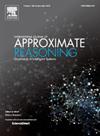Cauchy Graph Convolutional Networks
IF 3
3区 计算机科学
Q2 COMPUTER SCIENCE, ARTIFICIAL INTELLIGENCE
引用次数: 0
Abstract
A common approach to learning Bayesian networks involves specifying an appropriately chosen family of parameterized probability density such as Gaussian. However, the distribution of most real-life data is leptokurtic and may not necessarily be best described by a Gaussian process. In this work we introduce Cauchy Graphical Models (CGM), a class of multivariate Cauchy densities that can be represented as directed acyclic graphs with arbitrary network topologies, the edges of which encode linear dependencies between random variables. We develop CGLearn, the resultant algorithm for learning the structure and Cauchy parameters based on Minimum Dispersion Criterion (MDC). Experiments using simulated datasets on benchmark network topologies demonstrate the efficacy of our approach when compared to Gaussian Graphical Models (GGM). Most Graph Convolutional Neural Networks (GCN) process input graphs as ground-truth representations of node relationships, yet these graphs are constructed based on modeling assumptions and noisy data and their use may lead to suboptimal performance on downstream prediction tasks. We propose Cauchy GCN which leverages CGM to infer graph topology that depicts latent relationships between nodes. We evaluate the effectiveness and quality of the structural graphs learned by CGM, and demonstrate that Cauchy-GCN achieves superior performance compared to widely used graph construction methods.
柯西图卷积网络
学习贝叶斯网络的一种常用方法包括指定一个适当选择的参数化概率密度族,例如高斯。然而,大多数实际数据的分布是细峰的,不一定能用高斯过程来最好地描述。在这项工作中,我们引入了柯西图模型(CGM),这是一类多元柯西密度,可以表示为具有任意网络拓扑的有向无环图,其边缘编码随机变量之间的线性依赖关系。我们开发了CGLearn,这是基于最小色散准则(Minimum Dispersion Criterion, MDC)学习结构和柯西参数的结果算法。在基准网络拓扑上使用模拟数据集的实验表明,与高斯图形模型(GGM)相比,我们的方法是有效的。大多数图卷积神经网络(GCN)处理输入图作为节点关系的真值表示,然而这些图是基于建模假设和噪声数据构建的,它们的使用可能会导致下游预测任务的次优性能。我们提出了柯西GCN,它利用CGM来推断描述节点之间潜在关系的图拓扑。我们评估了CGM学习的结构图的有效性和质量,并证明了与广泛使用的图构造方法相比,Cauchy-GCN取得了更好的性能。
本文章由计算机程序翻译,如有差异,请以英文原文为准。
求助全文
约1分钟内获得全文
求助全文
来源期刊

International Journal of Approximate Reasoning
工程技术-计算机:人工智能
CiteScore
6.90
自引率
12.80%
发文量
170
审稿时长
67 days
期刊介绍:
The International Journal of Approximate Reasoning is intended to serve as a forum for the treatment of imprecision and uncertainty in Artificial and Computational Intelligence, covering both the foundations of uncertainty theories, and the design of intelligent systems for scientific and engineering applications. It publishes high-quality research papers describing theoretical developments or innovative applications, as well as review articles on topics of general interest.
Relevant topics include, but are not limited to, probabilistic reasoning and Bayesian networks, imprecise probabilities, random sets, belief functions (Dempster-Shafer theory), possibility theory, fuzzy sets, rough sets, decision theory, non-additive measures and integrals, qualitative reasoning about uncertainty, comparative probability orderings, game-theoretic probability, default reasoning, nonstandard logics, argumentation systems, inconsistency tolerant reasoning, elicitation techniques, philosophical foundations and psychological models of uncertain reasoning.
Domains of application for uncertain reasoning systems include risk analysis and assessment, information retrieval and database design, information fusion, machine learning, data and web mining, computer vision, image and signal processing, intelligent data analysis, statistics, multi-agent systems, etc.
 求助内容:
求助内容: 应助结果提醒方式:
应助结果提醒方式:


